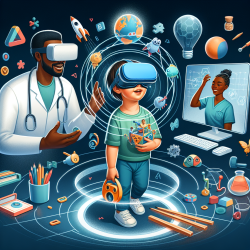The Rise of Virtual Visits in Developmental Screening: A Data-Driven Perspective
The COVID-19 pandemic has accelerated the adoption of virtual healthcare services, creating new opportunities and challenges for practitioners in the field of developmental screening. The research article titled "Virtual Visits for Developmental Screening in High-Risk Infants" offers valuable insights into the effectiveness of virtual visits compared to traditional in-person assessments. As a speech-language pathologist passionate about improving outcomes for children, understanding and implementing these findings can significantly enhance your practice.
Key Findings from the Study
The study conducted by Kaiser Permanente Downey's High-Risk Infant Follow-Up (HRIF) program compared developmental assessments conducted virtually with those conducted in person. The primary focus was on infants at high risk for developmental delays due to factors such as prematurity and low birth weight. Here are some critical takeaways:
- There were no significant differences in the rates of enrollment or referral to physical, occupational, or speech therapy services between virtual and in-person visits.
- The rate of referral at any of the three standard visits was 8.6% for in-person visits and 10.9% for virtual visits, a statistically insignificant difference (p = 0.49).
- Infants whose first visit was virtual were just as likely to complete all three developmental assessments as those whose first visit was in person.
Implications for Practitioners
For practitioners, these findings suggest that virtual visits can be a viable alternative to in-person assessments, particularly in situations where in-person visits are not feasible. Here are some ways to incorporate these insights into your practice:
- Embrace Telehealth: Consider offering virtual assessments as part of your service portfolio, especially for families who face logistical challenges in attending in-person sessions.
- Utilize Available Tools: While the Bayley Infant Neurodevelopmental Screener (BINS) was used in the study, it's essential to explore other standardized tools like the Developmental Assessment of Young Children, second edition (DAYC-2), which can be effectively used in virtual settings.
- Educate Families: Provide guidance to families on how to prepare for virtual assessments, including setting up the environment and using household items as substitutes for standardized toys.
Encouraging Further Research
While the study provides promising evidence for the effectiveness of virtual visits, it also highlights the need for further research. Larger-scale studies with standardized assessments are necessary to validate these findings and explore new tools that can enhance virtual developmental screenings.
As practitioners, staying informed about ongoing research and advancements in telehealth can help you adapt to the evolving landscape of healthcare delivery. By actively participating in research initiatives or collaborating with academic institutions, you can contribute to the development of best practices in virtual developmental assessments.
Conclusion
The study "Virtual Visits for Developmental Screening in High-Risk Infants" demonstrates that virtual visits can be an effective and convenient option for developmental screenings. By integrating these findings into your practice, you can provide high-quality care to children and families while embracing the benefits of telehealth.
To read the original research paper, please follow this link: Virtual Visits for Developmental Screening in High-Risk Infants.










